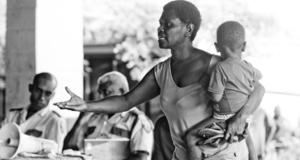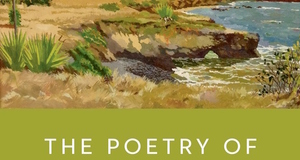Contemporary Poetry's Influence on Cross-Cultural Perceptions
By
2011, Vol. 3 No. 02 | pg. 2/2 | « In lines 24 and 25, the narrator references a “war...declared ended, almost before it has begun” and then a war named “The Ultimate Combat between Nearness and Distance”. Considering the social and historical context of the poem and the year it was written – 1994 – readers must begin to wonder which war the narrator is referencing at this point. He has already mentioned the World Wars and seems now to be pointing to the third World War, one less physical and instead far more mental and emotional, one of cultural misunderstandings rather than missiles. However, this is an alarming set of lines, as it is almost always misunderstanding between cultures and countries that leads to actual physical wars. Here, Palmer, through his narrator, seems to be warning of a bleak future: humans must find the commonality between us all, must overlook the comparatively inconsequential differences and focus instead on the basal emotions we all share, emotions most effectively expressed and explored by poets, writers, and all artists. If these connections are not made, war is inevitable, as it has been in thousands of years past. Civilizations will implode within themselves and our species will die out on account of us and our unwillingness to understand one another. Palmer’s final line, though the same as his opening “I do not know English,” holds a different and far heavier tone at the poem’s close. Whereas the initial message was one of language dissonance and confusion from a narrator who does not understand, the last line is full of meaning and foreboding, a warning from someone who sees all too clearly the driving flaw in humanity.Today, some are finally starting to heed the warnings of poets like Palmer. Stephen Cockett examined the use of poetry to bring people from different cultures together in his 2002 “Verse in Action: Performing Poetry to Learners of English as a Second Language in Poland”. As the title hints, the article covers a relatively recent project sponsored by the British Council in Poland: eight students from the Drama department of Exeter University were chosen to act out performance poetry in a handful of schools in rural Poland, before an audience of young children who spoke very minimal, if any, English. The experiment was conducted with hopes for positive results to affirm that learning happens most readily through the arts, and that poetry (as well as drama) is a very effective medium for establishing human connections. The student-actors targeted primary school-aged children in hopes of getting a message across to them at an early age, before the children had the chance to become oversaturated in their own cultures and the cross-cultural discrimination that sometimes occurs along with national pride or patriotism. The project leaders hoped to use first the written word and then the performance of such as “an extra strategy enabling pupils to communicate spontaneously and with meaning at whatever their level of command” (Cockett 14). The poems were performed entirely in English with no translators. What all parties learned, whether they played the role of teacher or student, was that “Reading poetry for use with language learners quickly makes apparent how much meaning...depends on cultural knowledge...Culturally specific references resist expression across the language divide” (Cockett 16). Faced with these challenges, those involved with the project had to be especially careful when choosing material for their poetry show. Among those chosen were “funny poems about everyday things, evocative poems about more serious matters, [and] poems from different cultures” (15). The project, at least on a small scale, was deemed successful and future tours are currently in the making. Whether or not the young audience caught every word of every poem is debatable, but the fact that both pupils and performers came away with a greater knowledge of cross-cultural similarities and connections is without question – and all through the lens of poetry and art. Howard Moss addresses the same cultural divide and misperception of the foreign “other” in his 1976 “Tourists,” albeit employing a much lighter tone, as well as a hint of performance (similar to that used in the above-mentioned project in Poland). His poem consists of twelve two-line stanzas in couplet rhyming, which gives the tone a very light, almost comical feel that nearly betrays the more serious nature of the issue at hand. The meter, dactylic tetrameter, with four feet of unstressed-stressed-stressed syllables per line, contributes further to this lighthearted feel, adding a sing-song quality to the lines. Throughout the poem, Moss takes on the narrative voice of someone observing various tourists in Europe: the narrator does not seem overly judgmental of these visitors, but the use of a meter signifying a comical tone points towards a bias against the titled tourists. Furthermore, this poem differs from Palmer’s “I Do Not” in that it focus on American tourists and the stereotypes associated with the ignorant, over-entitled Americans by people of different nations all over the world. Here, though the American visitors are the ones placed in the “foreign” role, being perceived as one way or the other by the nation’s locals, the narrator seems less sympathetic than Palmer in his poem. Also, form fits content more so here than in Palmer’s poem, which depends heavily on irony to get a message across: Moss’ use of light, humorous meter and rhyme scheme mirrors the similarly humorous and “silly” nature (or at least stereotype) of the American tourist. At times, the poet even adds mid-sentence rhymes aside from the rhyme already seen in the end- words of each couplet, as in “Embarrassed in Paris in Harris tweed...” (9). Often, Moss must use enjambment to meet the requirements of the rhyme and meter, sometimes even breaking couplet stanza in the middle of a word – for example, in lines 9 and 10, “...dying to / Get to the next museum piece that they’re flying to” or, in lines 14 and 15, “...in-/ sensitive, garrulous, querulous, audible”. The extent to which the poet will go out of his way to fit the restrictions of form matches Europeans’ perception of the American tourist as trying so hard to fit in with their new environment that it comes off as overdone and ridiculous. In the opening couplet, the narrator describes American tourists as “Cramped like sardines on the Queens, and sedated,” which promotes the same animalized depiction of Americans as is examined in the belittling of non-English speaking immigrants in Palmer’s “I Do Not”. In fact, these foreigners (now, for once, the Americans) are so insignificant and dispensable that, in line 4, they are simply “dumped with their luggage at some frumpish harbor”. As the poem progresses, Moss continues to point out the many ways that Americans do not fit into the various European environments and cultures. In the poem’s narration, the Americans seem to have brought from overseas the United States city mentality of staying busy, acting busy, and being always in motion; this contrasts heavily with the generally more relaxed feel in Europe, where citizens place great importance on enjoying their surroundings and savoring experiences. Moss’ quintessential American tourists are “Veering through rapids in a vapid rapido” (here, perhaps, the tourists are attempting to fit in by speaking the native tongue) and always “dying to / Get to the next museum” (5, 9-10). Perhaps the tourists are more interested in seeing the things they “ought” to see than actually learning anything significant about the nation/s they are touring. For them, the trip is more a luxury than a learning experience, and it will do little in the way of changing their mindset about the world. Americans further ostracize themselves by being unable or unwilling to digest or enjoy the local cuisine: “Finding, in Frankfurt, that one indigestible / Comestible makes them too ill for the Festival” (11-12). Then the American tourists being to make a complete embarrassment of themselves, serving as a representation of the American stereotype and as poor ambassadors for the country as a whole while touring outside of it: “Drunk in the Dolomites, tuning a portable, / Homesick in Stockholm, or dressed to toboggan / At the wrong time of year” (16-20). In lines 19 and 20, Americans are also portrayed as weak, clueless, and too immature or ignorant to understand or accept a different culture when attempting to immerse themselves in it. Here, they are not only incapable of contributing any information or establishing any semblance of a human connection with their European counterparts, but they are actually imposters, intruders in a land they seem to care little about, imposing upon the citizens of this land and gaining no knowledge from the experience. At the poem’s conclusion, readers are able to follow the American intruders and see where they eventually end up: “Most will come home, but there will be some of them / Subsiding like Lawrence in Florence” (22-23). It seems Moss is indicating that, while those tourists who are unable to connect with the locals on the human level learn nothing and remain blissfully ignorant upon returning to the States. However, those rare few who are able to glean some sort of new information and meaning from their time abroad are often inclined to stay. The example he uses is English writer D. H. Lawrence, who lived in Italy several times during his career and lifetime, which seems to point once again (as did Palmer’s poem) that it is the poets and writers among us most apt to understand the human condition we share with one another. Therefore, it seems the responsibility of poets, writers, and artists to make the human condition readily available for the public through their various media, whether it be pen and paper or canvas. We cannot begin to address issues like poverty, disease, and war until we first learn to better relate to one another above and beyond the boundaries we allow cultural differences to build between us. Both Michael Palmer and Howard Moss, the former through the serious direct tone of a Language poet and a reliance on irony and the latter through a more lighthearted, humorous lens, use the medium of written word, particularly poetry, to establish the shared similarities between all human beings by examining the differences in various human cultures. Both poems conclude with the idea that, while differences do exist, there are always exceptions to our preconceived notions about one another and, in fact, that the exceptions can often outweigh the rules. In “I Do Not,” the non-English speaking immigrant is actually intelligent, firm of opinion, and both well- read and well-spoken – an image and characterization that contrasts sharply with Americans’ ideas about foreigners in our country. In “Tourists,” readers find that not all American tourists visiting other countries are ignorant of these other cultures; in fact, some Americans find they are better able to relate with Europeans than with fellow inhabitants of the States, and subsequently become ex-patriots. Perhaps if we, as a species, consider each person on an individual basis – unmarked by unsupported perceptions based on culture and ethnic background – we will be more likely to learn about one another on a personal level. And what is more personal than the written word, more powerful than poetry? Through exposure to various poets’ individual accounts of the pleasures and pains of the human condition, readers will be able to, first, better understand themselves and, then, better identify with one another – then, one hopes, this connection through the page will translate into the everyday interactions between different people, different countries, and different cultures. ReferencesCockett, Stephen. “Verse in Action: Performing Poetry to Learners of English as a Second Language in Poland.” Children’s Literature in Education 33.1 (2002): 11-28. Academic Search Premier. EBSCO. Web. 5 Dec. 2009. Moss, Howard. “Tourists.” The Norton Anthology of Poetry. Eds. Ferguson, Margaret, Mary Jo Salter, and Jon Stallworthy. New York: W. W. Norton & Company, Inc., 2005. 1660- 61. Print. Palmer, Michael. “I Do Not.” The Norton Anthology of Poetry. Eds. Ferguson, Margaret, Mary Jo Salter, and Jon Stallworthy. New York: W. W. Norton & Company, Inc., 2005. 1937- 38. Print. Yu, Timothy. “Form and Identity in Language Poetry and Asian American Poetry.” Contemporary Literature 41.3 (2000): 422-461. University of Wisconsin Press. JSTOR. Web. 5 Dec. 2009. Suggested Reading from Inquiries Journal
Inquiries Journal provides undergraduate and graduate students around the world a platform for the wide dissemination of academic work over a range of core disciplines. Representing the work of students from hundreds of institutions around the globe, Inquiries Journal's large database of academic articles is completely free. Learn more | Blog | Submit Latest in Literature |


















